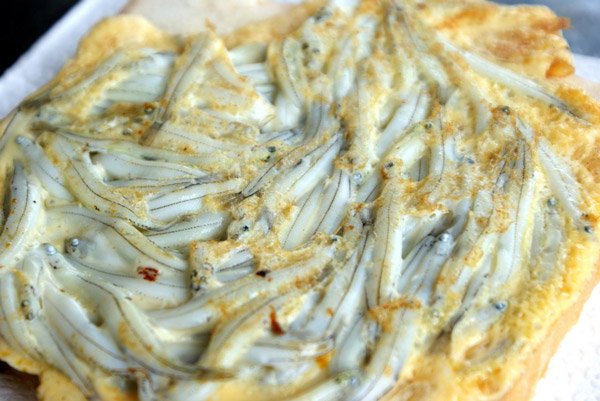Whitebait: El pez pequeño con un gran precio
¿Qué son los whitebait?
En Nueva Zelanda el término alevín o whitebait describe a las formas juveniles (alrededor de 4 a 5 centímetros de largo) de cinco especies de peces de la familia Galaxiidae.
La palabra Maorí para el whitebait es Inanga.
¿Cómo pescarlos?
El término que se utiliza para la pesca de estos peces pequeños es ‘whitebaiting’. El método habitual para atrapar a los alevines o whitebait es utilizando una red de malla fina que se sostiene con las manos o se coloca a lo largo de las riberas. Cuando son jóvenes los peces son transparentes lo cual le dificulta a los depredadores verlos. A menudo mientras se pesca se “camina” detrás de un cardumen de peces y se guían dentro de la red
¿Existen regulaciones para pescarlos?
Hace más de cien años en Nueva Zelanda los whitebait se pesaban en toneladas; un siglo después se medían en latas de queroseno, luego libras y ahora la medida más común es en tazas ya que pocos whitebait son pescados.
Algunas de las razones por las que los números han caído incluyen la sobrepesca, los humedales drenados, serrín deslavado de aserraderos y los residuos agrícolas. El mayor daño proviene de la ganadería que pisotea la vegetación a lo largo de las riberas de los ríos, y destruye el hábitat necesario para el desarrollo de los huevos.
Hoy en día las regulaciones de pesca están a cargo del Departamento de Conservación. Para consultar las regulaciones sobre el whitebait puede visitar su sitio web: http://www.doc.govt.nz/whitebait
Para consultar las regulaciones sobre el whitebait puede visitar su sitio web: http://www.doc.govt.nz/whitebait
¿Dónde encontrar whitebait?
El Whitebait frecuentemente nada en bancos a lo largo de la costa de Nueva Zelanda,antes de buscar su camino corriente arriba en el mar, nadan pegados a la orilla de los ríos. A los grandes bancos usualmente se les llama corridas.
El Inanga (Galaxias maculatus) es una de las muchas especies de whitebait, estos representan alrededor del 95 por ciento del whitebait que se come en la parte continental de Nueva Zelanda. Ellos son parte de una amplia familia de peces de agua dulce llamados los ‘galaxiids’ que viven exclusivamente en el hemisferio sur.
Las mismas especies de alevines nadan en las Islas Chatham, los ríos de Chile y Argentina, en las Islas Malvinas y la Isla de Lord Howe así como en Tasmania en Australia.
Los whitebait se encuentran a lo largo de Nueva Zelanda en lugares como la Bahía de Plenty, Río Otaki, Río Awakino, Río Taieri, Baja del río Clutha y Caitlins, lugar donde se encuentran los whitebait más reconocidos y las corridas más grandes en el Sudoeste.
¿Cuándo es temporada de whitebait?
La temporada del whitebait es en primavera-generalmente, y tiene una duración desde mediados de Agosto hasta Noviembre, aunque las Islas Chatham tienen una temporada distinta.
Comiendo whitebait
Cada vez es más difícil pescar whitebait y si usted visita cualquier supermercado Kiwi o pescadería los precios reflejan lo siguiente – El whitebait fresco se vende alrededor de los 100 a 125 NZD por kilo.
La manera más popular de cocinar el whitebait en Nueva Zelanda es la fritada de whitebait, que basicamente es un omelette que contiene whaitbait. Los puristas utilizan únicamente la clara de huevo con el fin de minimizar la mezcla del sabor del huevo con el pescado. Es muy sencillo de hacer – se mezclan unos huevos, dos cucharadas de harina, una cucharadita de polvo para hornear y sal, y tanto whitebait como sea posible. Luego se frie a cucharadas en mantequilla o aceite.
Las fritadas a menudo se comen acompañadas de rebanadas de pan blanco con mantequilla.
Top 5 de lugares Kiwi para probar el whitebait
Cibo en Parnell, Auckland ofrece dos opciones acompañadas de una deliciosa salsa de soya, limón y mantequilla de jengibre- servido tradicionalmente en un omelette o ligeramente espolvoreado con harina y crocante.
Curly Tree Whitebait ubicado en la autopista número 6 de la Costa Oeste al norte de Haast. Si usted
está viajando de los glaciares Franz o Fox a Wanaka y Queenstown tendría que ir en dirección a
Haast. ‘Curly’s’ es uno de los lugares más emblemáticos de Nueva Zelanda para probar las fritadas de whitebait.
En Invercargill, en la punta de la Isla Sur, Jimmy Fairweather lo recibirá feliz con una fritada de whitebait recién salida de la cazuela. Jimmy es propietario de un carro de comida y lo puede encontrar estacionado los días lunes en la calle Gala Street Reserve dónde él mismo cocina las fritadas de whitebait durante la temporada así como su famosa crema de mariscos.
Para comer una fritada de whitebait sin tanto glamour servida con pan con mantequilla, visite a Jimmy The Fish en la calle Ponsonby en Auckland. Huevo,harina, sal, pimienta, whitebait fresco y listo !
Otro lugar para comer en Ponsonby, el icónico y súper genial SPQR es para todos los gustos , mantendrá a todos los hispsters contentos con su fritada libre de gluten acompañada de mantequilla de limón y salsa de cebollino.
Si le gustaría probar sus habilidades en el whitebaiting, póngase en contacto con nosotros y podremos darle ideas acerca de increíbles lugares en Nueva Zelanda, podemos personalizar paquetes de aventura al aire libre que se adapten a sus necesidades.
Síganos en Twitter para mantenerse actualizado con nuestras últimas noticias @blacklabelexp.



